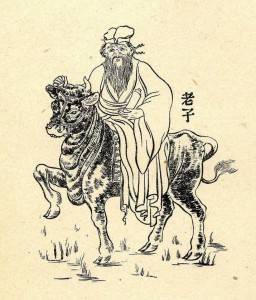
The Book of the Simple Way is translation of the original text of the Tao-Teh-King published in 1904. Here are some lines from the discussions in the introduction:
By acting while separating oneself from action, and by reaching the fruit of action without desiring it, man ceases to identify himself with good or evil in the world and reaches a state wherein diversity is perceived as unity, and all distinctions cease. Hope is no more, there is nothing unfulfilled; ambition has no aim, for all things are attained; and effort has no use, for necessity has ceased.
Then follows the question, Can one attain liberation for oneself alone? Laotze says No. Buddha says No. Christ says No. Not one of all the great Teachers and Saints ever desired or thought of such beatitude for himself alone. Indeed, it seems to be a law of spiritual evolution that the nearer one comes to the attainment of spiritual bliss the less he desires it for himself alone.
Download the public domain work here (190 pages/19Mb):
 The Book of the Simple Way
The Book of the Simple Way
What is The Book of the Simple Way about?
Here are some of the important teachings and insights from “The Book of the Simple Way,” also known as “Xin Xin Ming” or “Trust in Mind”
- Trust in Mind: The central theme of the text is to cultivate trust in one’s inherent nature or mind. It emphasizes that our true nature is originally pure and free from duality.
- Non-Duality: The text repeatedly emphasizes the idea of non-duality, that is, the absence of separation between the ordinary and the sacred, or between the enlightened and the unenlightened.
- Direct Experience: The teachings stress the importance of direct experience over relying on concepts or language. The mind is described as inherently pure but becomes clouded by attachments and judgments.
- The Great Way is Not Difficult: One of the most famous lines from the text is “The Great Way is not difficult for those who have no preferences.” This suggests that difficulties arise from clinging to preferences and judgments.
- Accepting Everything: The text encourages us to accept all experiences and states of mind as they are, without seeking to change or control them. This leads to a state of equanimity.
- Illusion of Good and Bad: The text teaches that our judgments of good and bad are merely constructs of the mind. When we let go of these judgments, we can see the world as it truly is.
- No Need to Seek: The text advises against seeking enlightenment outside of ourselves. True realization comes from recognizing our inherent nature.
- Empty of Self: The concept of emptiness is explored, suggesting that everything lacks inherent, separate existence. This understanding can lead to liberation from suffering.
- Stillness and Movement: The text talks about the relationship between stillness and movement. Even in motion, there can be a deep stillness within.
- Returning to the Source: The teachings guide practitioners to return to their original nature, letting go of mental constructs and returning to the simplicity of pure awareness.
- Letting Go of Attachment: Attachment to ideas, beliefs, and desires is seen as a source of suffering. By letting go, we find freedom.
- Unwavering Mind: The teachings emphasize cultivating an unwavering and clear mind that isn’t swayed by external circumstances.
These teachings highlight the essence of “The Book of the Simple Way.” It’s important to note that the text is deeply philosophical and contemplative, focusing on the nature of the mind and consciousness. It encourages practitioners to go beyond intellectual understanding and directly experience these truths for themselves through meditation and mindfulness.

